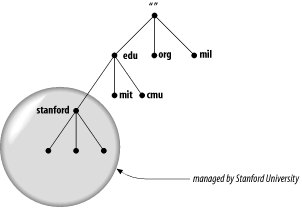Delegation
Remember that one of the main goals of the design of the Domain Name System was to decentralize administration? This is achieved through delegation. Delegating domains works a lot like delegating tasks at work. A manager may break up a large project into smaller tasks and delegate responsibility for each of these tasks to different employees.
Likewise, an organization administering a domain can divide it into subdomains. Each of those subdomains can be delegated to other organizations. This means that an organization becomes responsible for maintaining all the data in that subdomain. It can freely change the data and even divide its subdomain into more subdomains and delegate those. The parent domain retains only pointers to sources of the subdomain’s data, so that it can refer queriers there. The domain stanford.edu, for example, is delegated to the folks at Stanford who run the university’s networks (see Figure 2-7).
 |
Not all organizations delegate away their whole domain, just as not all managers delegate all their work. A domain may have several delegated subdomains and also contain hosts that don’t belong in the subdomains. For example, the Acme Corporation (it supplies a certain coyote with most of his gadgets), which has a division in Rockaway and its headquarters in Kalamazoo, might have a rockaway.acme.com ...
Get DNS on Windows Server 2003, 3rd Edition now with the O’Reilly learning platform.
O’Reilly members experience books, live events, courses curated by job role, and more from O’Reilly and nearly 200 top publishers.

